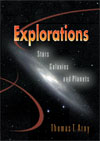Astronomers, like all scientists, rely heavily on observations to guide them
in theorizing and in testing theories already developed. Unlike most scientists,
however, astronomers cannot directly probe the objects they study. Rather, they
must perform their observations from vast distances and can only passively collect
radiation emitted by the bodies they seek to study. Collecting enough radiation
to be useful in studying astronomical objects is difficult because most objects
are so remote that their radiation is extremely faint by the time it reaches
Earth. Moreover, special instruments must be used to extract the information
desired from the radiation--instruments that can measure the brightness, the
spectrum, and the position of objects to high precision. For example, to collect
enough light to detect remote galaxies, astronomers use telescopes with mirrors
the size of a small swimming pool. To avoid the blurring and blocking effects
of our atmosphere, they use orbiting observatories. To analyze and display the
observations, they use a computer. This chapter describes some of the more important
devices and how they work. We will see that modern telescopes bear little resemblance
to the long tubes depicted in cartoons. Moreover, modern astronomers rarely
sit at the eyepiece of a telescope. They are more likely to be sitting at a
computer terminal operating a telescope remotely, examining the data collected,
or solving equations that describe, for example, the paths of stars when two
galaxies collide. |



 2002 McGraw-Hill Higher Education
2002 McGraw-Hill Higher Education